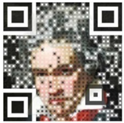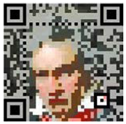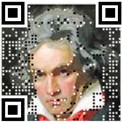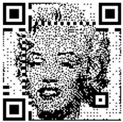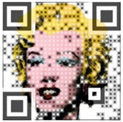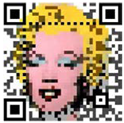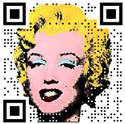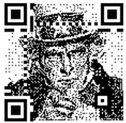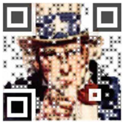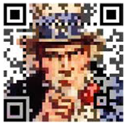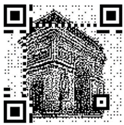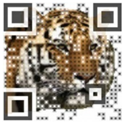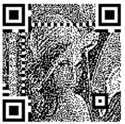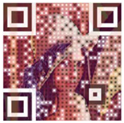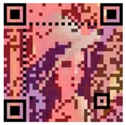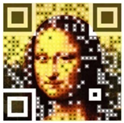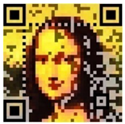A Novel Aesthetic QR Code Algorithm Based on Hybrid Basis Vector Matrices
Abstract
:1. Introduction
- The construction of the RBVM and the PBVM are extended from the basis vector matrix that was proposed by Cox [21]. Compared with the aesthetic methods, which are limited in our data area, our algorithm can achieve the replacement of the data area and the parity area of the QR code by the hybrid basis vector matrices of the PBVM and the RBVM. Thus, the replaceable area of the background image is extended. PBVM or RBVM can be flexibly chosen to obtain the optimal aesthetic effect for different image content.
- An image-synthetic strategy is proposed based on the alpha mask of several different shapes, which can reduce the difference between the QR code and the background image, and make the QR code more pleasant.
- In order to reduce the modification effect on the data area while modifying the parity area, an evaluation mechanism is designed on the basis of the Lasso principle [22] to determine which bits of parity area are the most appropriate to be modified.
2. Overview
2.1. RS Code-Encoding Mechanism
2.2. XOR Operation of RS Code
3. Algorithm
3.1. Preprocessing of Background Image
3.2. Construction of PBVM and RBVM
3.3. Replacement of QR Code Module
| Algorithm 1. |
| 1. Threshold value Vo is obtained by the Otsu method. 2. For each block in the data area and parity area of the QR code IQ (as shown in red and yellow box) 3. get average Va of pixels in corresponding block of gray image IG 4. if Va > Vo then 5. Set corresponding module of IQ to white 6. else 7. Set corresponding module of IQ to black 8. end |
3.4. Synthetic Strategy of Background Image and QR Code
4. Experimental Results
4.1. Integrity Test of the Aesthetic QR Code
- (a)
- Retaining the integrity of the background image in the aesthetic QR code.
- (b)
- Adjusting the replaceable areas dynamically.
- (c)
- Getting rid of the block effects around the aesthetic QR code in Lin et al. [19].
4.2. Error-Correction Rate of Aesthetic QR Code
4.3. Subjective Visual Effect of Aesthetic QR Code
4.4. Objective Visual Effect of Aesthetic QR Code
4.5. Correctness of QR Code Decoding
4.6. The Influence of Lighting Condition and Scanning Angles
5. Conclusions
Author Contributions
Funding
Conflicts of Interest
References
- Kan, T.W.; Teng, C.H.; Chou, W.S. Applying QR code in augmented reality applications. In Proceedings of the VRCAI ’09 8th International Conference on Virtual Reality Continuum and its Applications in Industry, Yokohama, Japan, 14–15 December 2009; pp. 253–257. [Google Scholar]
- Nikolaos, T.; Kiyoshi, T. QR-code calibration for mobile augmented reality applications: Linking a unique physical location to the digital world. In Proceedings of the SIGGRAPH ’10 ACM SIGGRAPH 2010, Los Angeles, CA, USA, 26–30 July 2010; p. 144:1. [Google Scholar]
- Reed, I.S.; Solomon, G. Polynomial Codes Over Certain Finite Fields. J. Soc. Ind. Appl. Math. 1960, 8, 300–304. [Google Scholar] [CrossRef]
- Falcon, A. 40 Gorgeous QR Code Artworks That Rock. 2013. Available online: http://www.hongkiat.com/blog/qr-code-artworks/ (accessed on 10 November 2017).
- Wakahara, T.; Yamamoto, N. Image processing of 2-dimensional barcode. In Proceedings of the 14th International Conference on Network-Based Information Systems, NBiS 2011, Tirana, Albania, 7–9 September 2011; pp. 484–490. [Google Scholar]
- Toshihiko, W.; Noriyasu, Y.; Hiroki, O. Image processing of dotted picture in the QR code of cellular phone. In Proceedings of the International Conference on P2P, Parallel, Grid, Cloud and Internet Computing, PGCIC, Fukuoka, Japan, 4–6 November 2010; pp. 454–458. [Google Scholar]
- Ono, S.; Morinaga, K.; Nakayama, S. Two-dimensional barcode decoration based on real-coded genetic algorithm. In Proceedings of the IEEE Congress on Evolutionary Computation, CEC (IEEE World Congress on Computational Intelligence), Hong Kong, China, 1–6 June 2008; pp. 1068–1073. [Google Scholar]
- Baharav, Z.; Kakarala, R. Visually significant QR codes: Image blending and statistical analysis. In Proceedings of the 2013 IEEE International Conference on Multimedia and Expo (ICME), San Jose, CA, USA, 15–19 July 2013; pp. 1–6. [Google Scholar]
- Fujita, K.; Kuribayashi, M.; Morii, M. Expansion of Image Displayable Area in Design QR Code and Its Applications. Inform. Sci. Technol. Forum Conf. Pap. 2011, 10, 517–520. [Google Scholar]
- Lin, Y.H.; Chang, Y.P.; Wu, J.L. Appearance-based QR code beautifier. IEEE Trans. Multimed. 2013, 15, 2198–2207. [Google Scholar] [CrossRef]
- Chu, H.K.; Chang, C.S.; Lee, R.R.; Mitra, N.J. Halftone QR codes. ACM Trans. Graph. 2013, 32, 217:1–217:8. [Google Scholar]
- Fang, C.F.; Zhang, C.W.; Chang, E.C. An optimization model for aesthetic two-dimensional barcodes. MultiMedia Modeling. In Proceedings of the 20th Anniversary International Conference, MMM 2014, LNCS8325, Dublin, Ireland, 6–10 January 2014; Springer International Publishing: Cham, Switzerland, 2014; pp. 278–290. [Google Scholar]
- V. Company, V. Visual QR Code. 2018. Available online: http://www.visualead.com/ (accessed on 21 September 2018).
- E. Company, E. Egoditor UG. 2018. Available online: https://www.qr-code-generator.com (accessed on 21 September 2018).
- Kuribayashi, M.; Morii, M. Enrichment of Visual Appearance of Aesthetic QR Code; IWDW 2015, LNCS 9569; Springer: Cham, Switzerland, 2016; pp. 220–231. [Google Scholar]
- Garateguy, G.J.; Arce, G.R.; Lau, D.L.; Villarreal, O.P. QR images: Optimized image embedding in QR codes. IEEE Trans. Image Process. 2014, 23, 2842–2853. [Google Scholar] [CrossRef] [PubMed]
- Li, L.; Li, Y.Y.; Wang, B.; Lu, J.F.; Zhang, S.Q.; Yuan, W.Q.; Wang, S.J.; Chang, C.C. A New Aesthetic QR Code Algorithm Based on Salient Region Detection and SPBVM. In Security with Intelligent Computing and Big-Data Services; SICBS 2017; Peng, S.L., Wang, S.J., Balas, V., Zhao, M., Eds.; Springer: Cham, Switzerland, 2018; pp. 20–32. [Google Scholar]
- Kuribayashi, M.; Morii, M. Aesthetic QR code based on modified systematic encoding function. IEICE Trans. Inf. Syst. 2017, E100-D, 42–51. [Google Scholar] [CrossRef]
- Lin, S.S.; Hu, M.C.; Lee, C.H.; Lee, T.Y. Efficient QR code beautification with high quality visual content. IEEE Trans. Multimed. 2015, 17, 1515–1524. [Google Scholar] [CrossRef]
- Li, L.; Qiu, J.X.; Lu, J.F.; Chang, C.C. An aesthetic QR code solution based on error correction mechanism. J. Syst. Softw. 2015, 116, 85–94. [Google Scholar] [CrossRef]
- Cox, R. Qartcodes. April 2012. Available online: http://research.swtch.com/qart (accessed on 12 April 2012).
- Bach, F.R. Consistency of the Group Lasso and Multiple Kernel Learning. J. Mach. Learn. Res. 2007, 9, 1179–1225. [Google Scholar]
- Li, C.; Zhang, T.Q.; Liu, Y. Blind recognition of RS codes based on Galois Field Columns Gaussian Elimination. Telecommun. Eng. 2014, 54, 926–931. [Google Scholar]
- Cox, R. Finite Field Arithmetic and Reed-Solomon Coding. Apr. 2012. Available online: http://research.swtch.com/field (accessed on 10 April 2012).
- Otsu, N. A threshold selection method from gray-level histograms. IEEE Trans. Syst. Man Cybern. 1979, 9, 62–66. [Google Scholar] [CrossRef]
- Information Technology—Automatic Identification and Data Capture Techniques—QR Code 2005 Bar Code Symbology Specification; ISO/IEC 18004; ISO: Geneva, Switzerland, 2006.
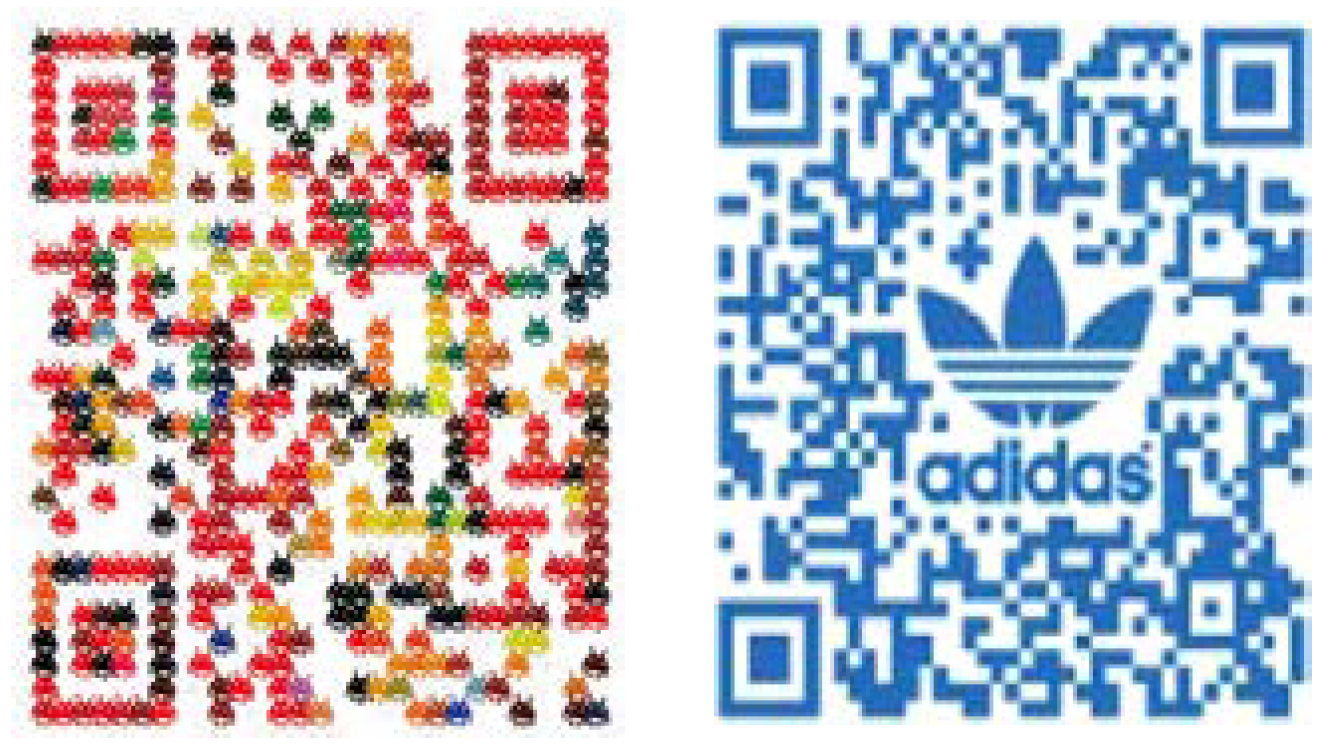

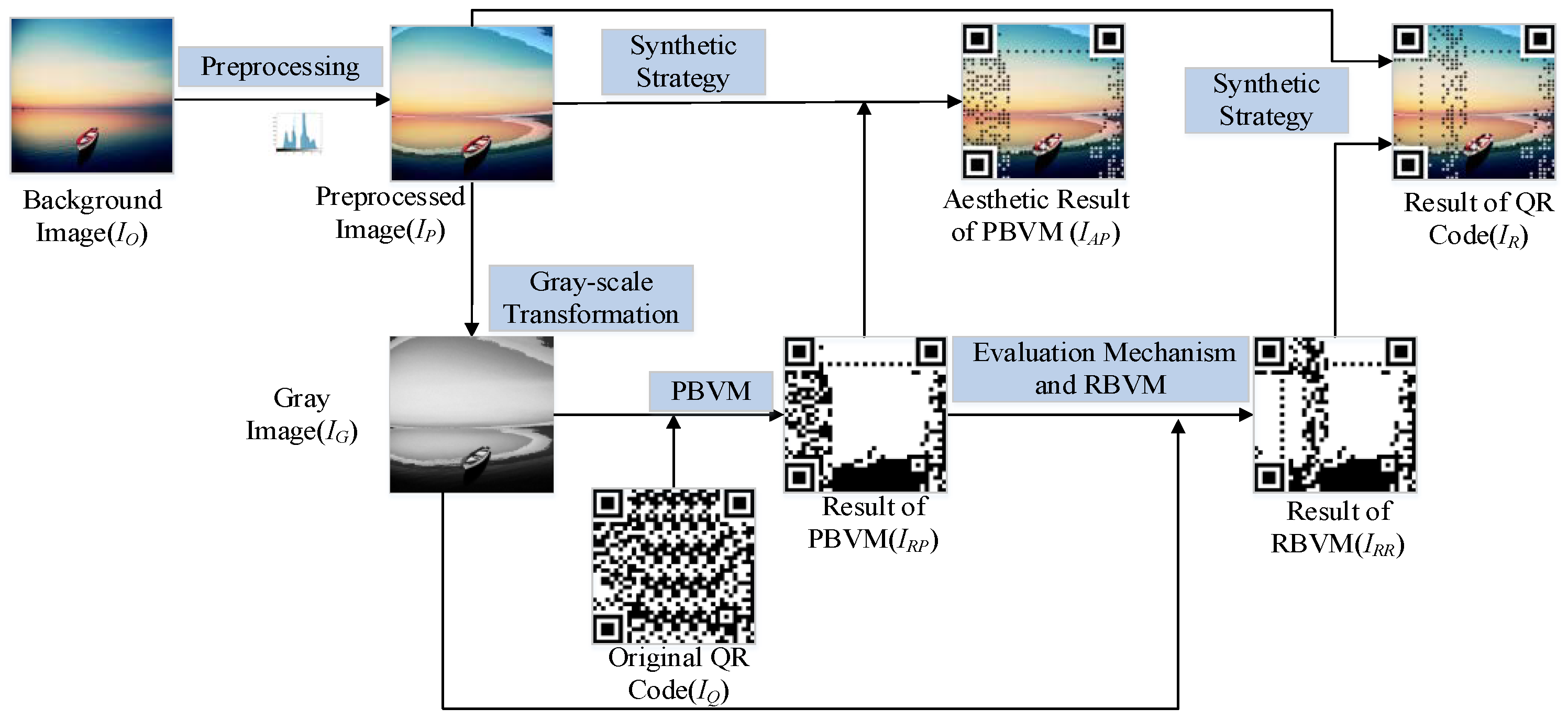
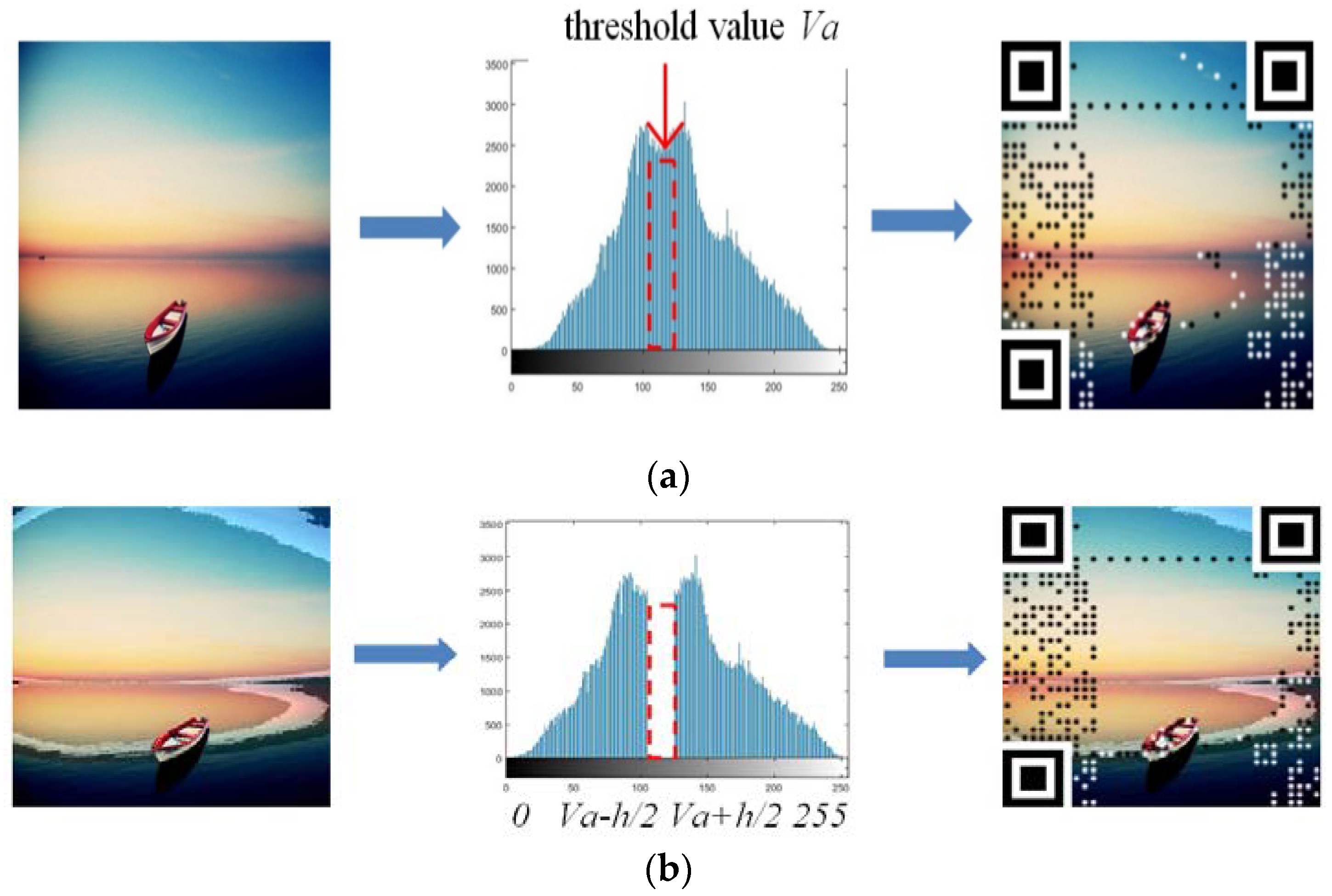
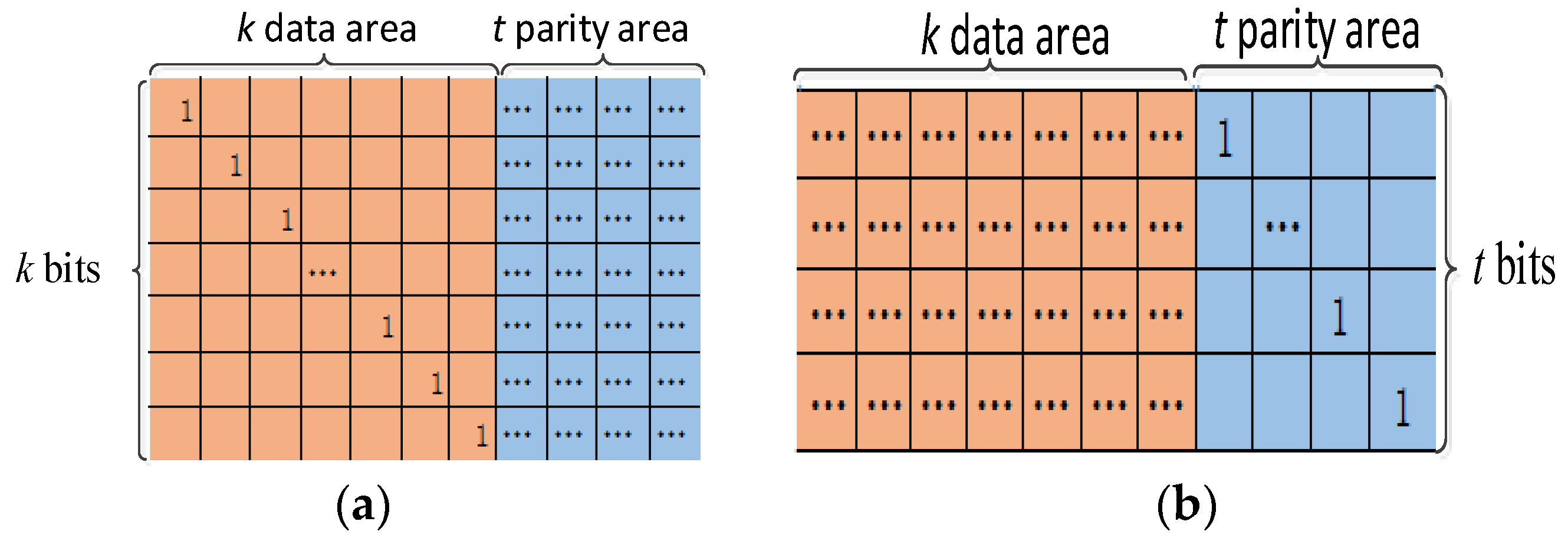
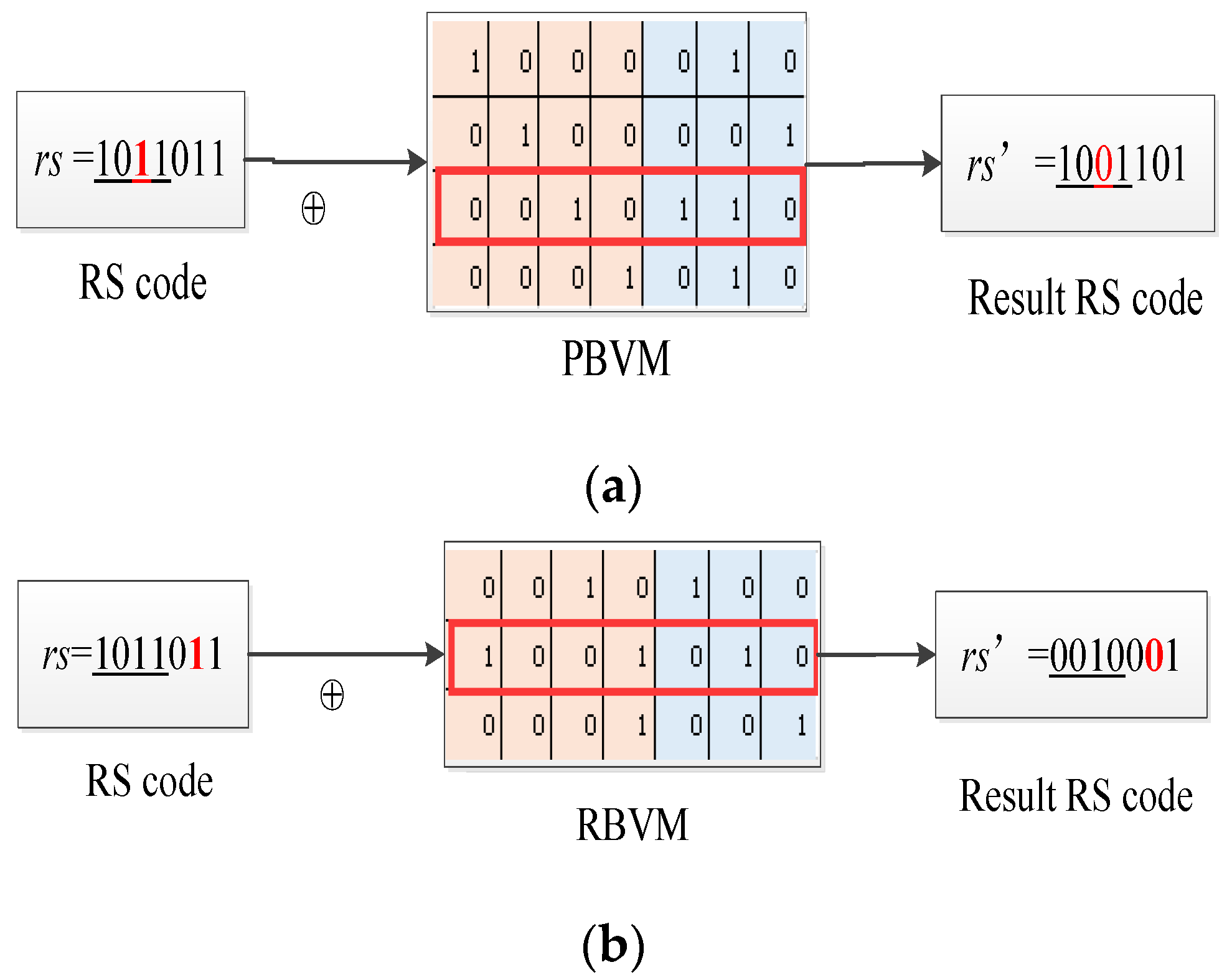
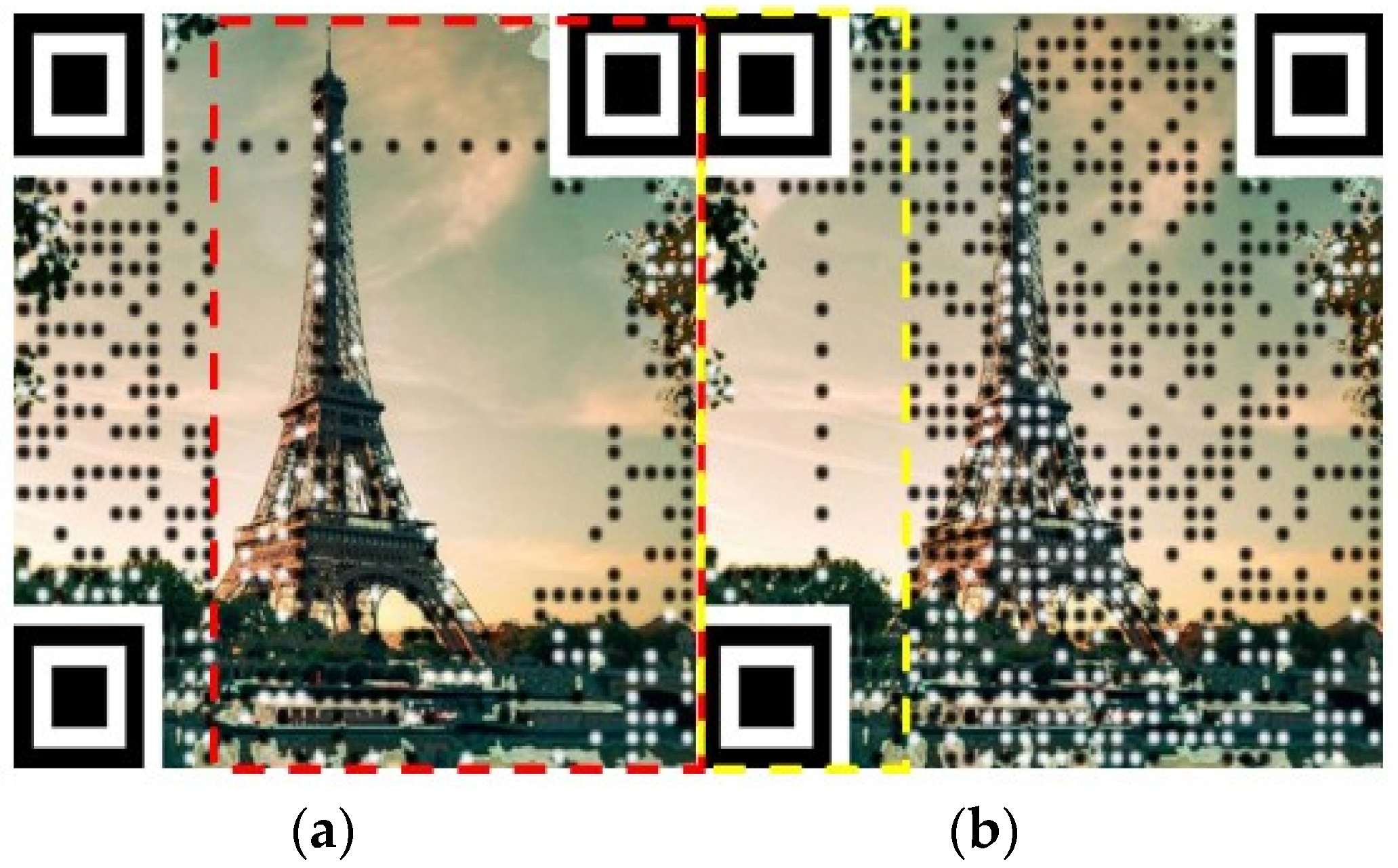

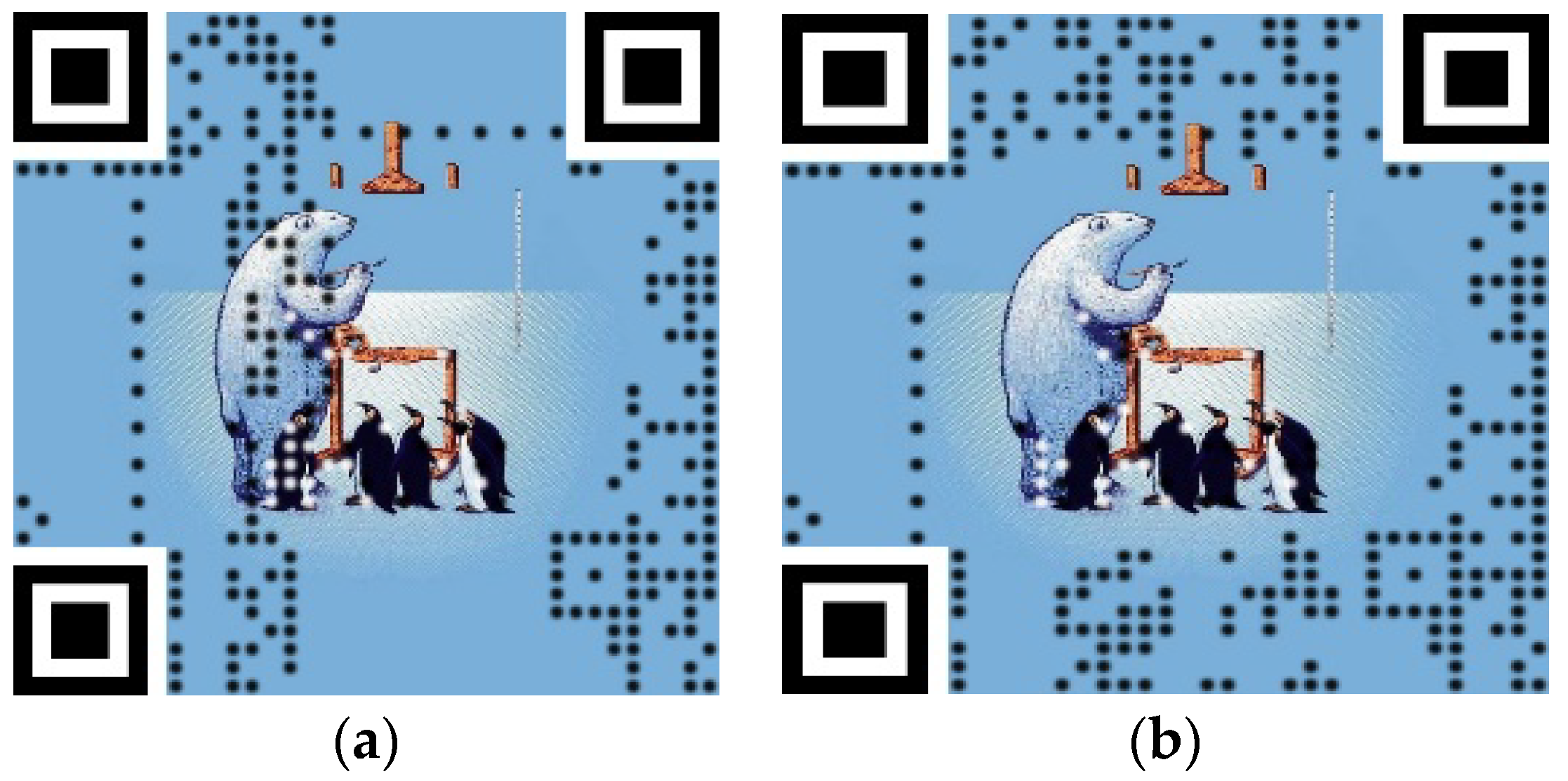
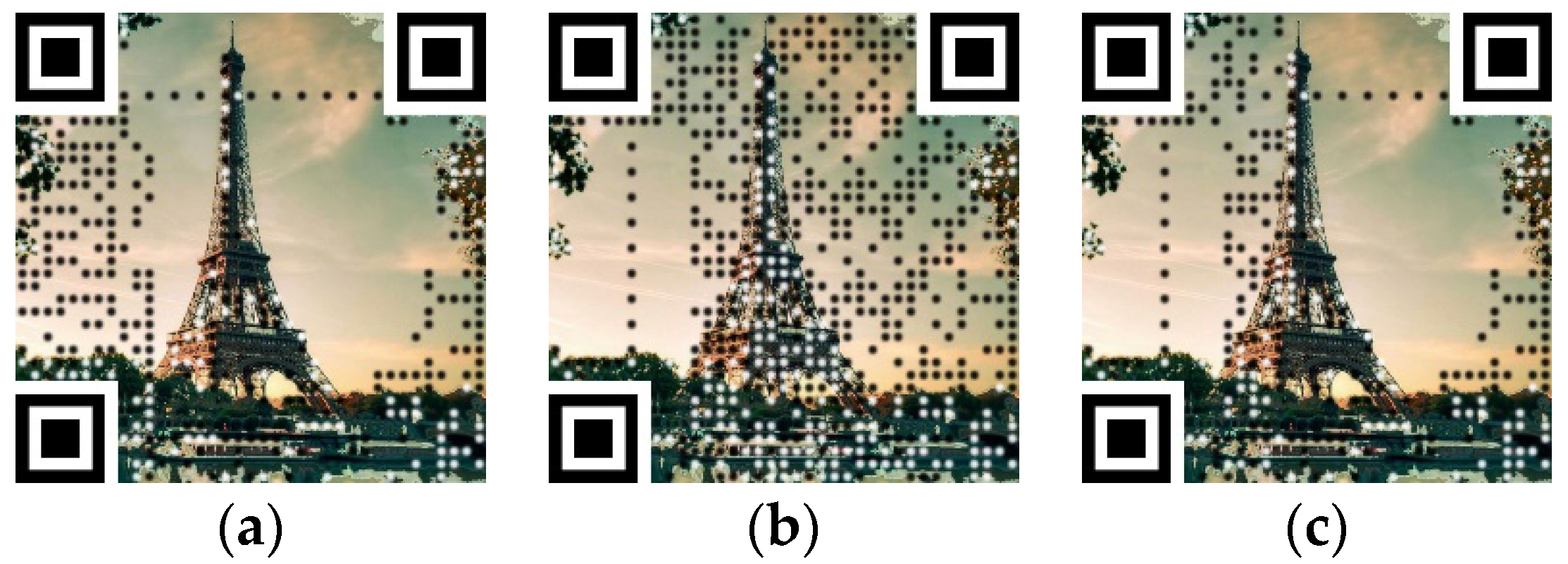
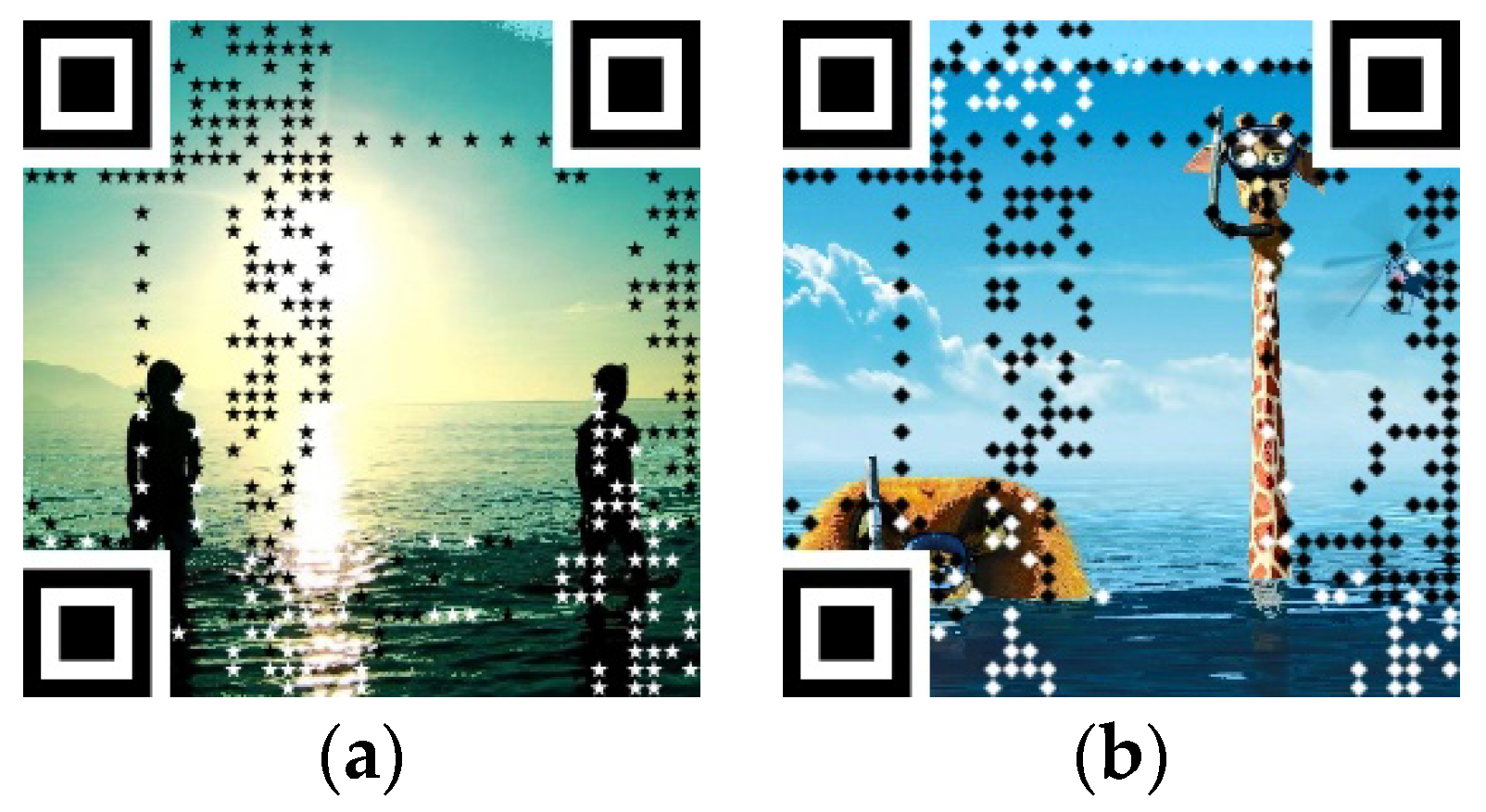
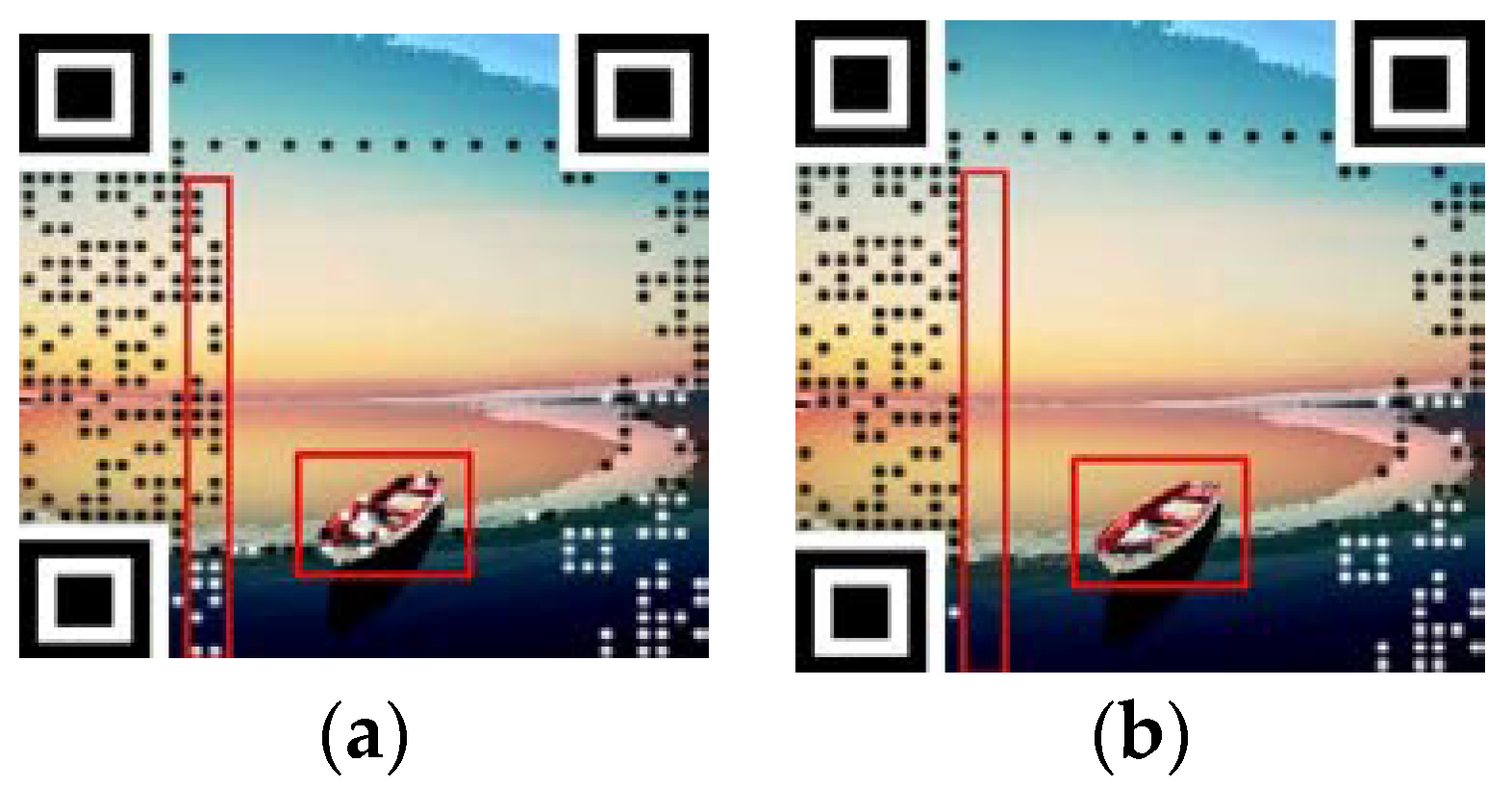
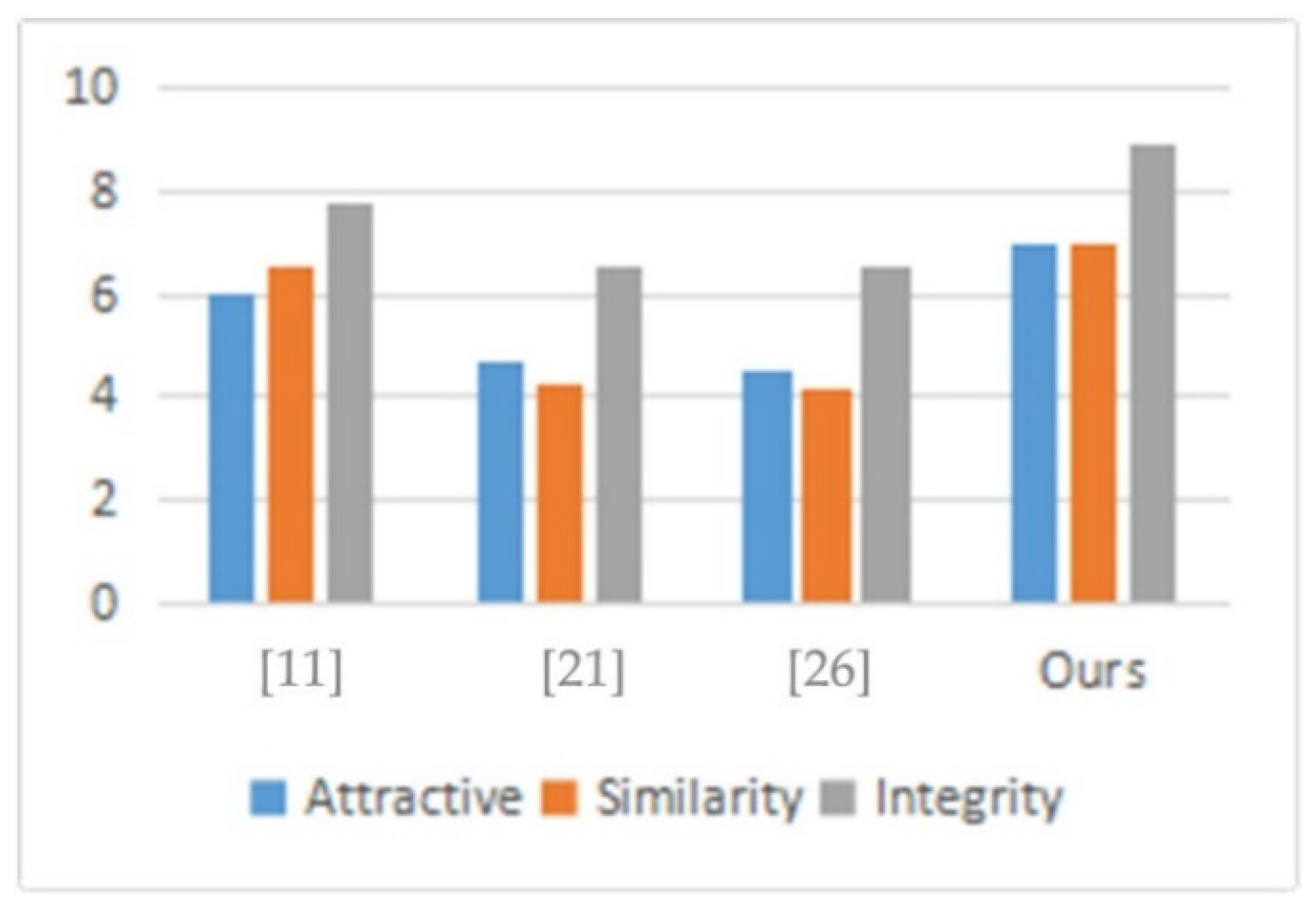
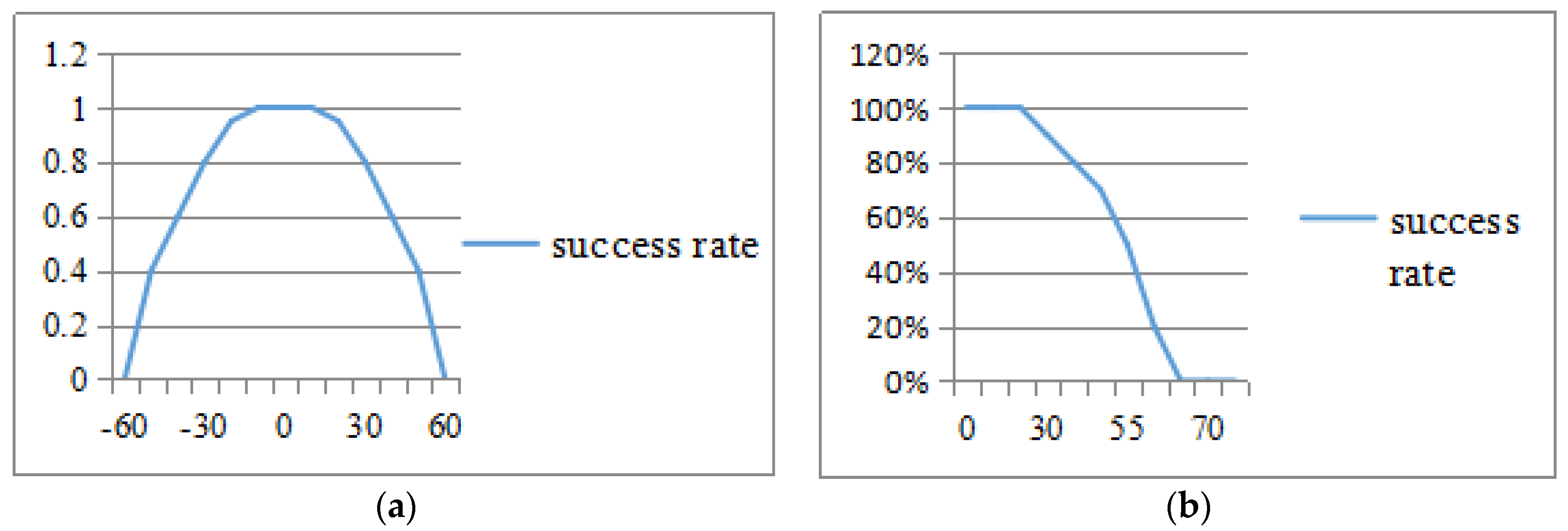
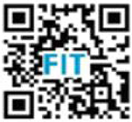 |  |  | 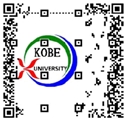 |
| Effect picture of Wakahara et al. [5] | Effect picture of Ono et al. [7] | Effect picture of Baharav et al. [8] | Effect picture of Fujita et al. [9] |
 |  | 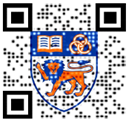 |  |
| Effect picture of Lin et al. [10] | Effect picture of Chu et al. [11] | Effect picture of Fang et al. [12] | Effect picture of V et al. [13] |
 | 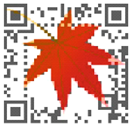 |  |  |
| Effect picture of E et al. [14] | Effect picture of Kuribayashi et al. [15] | Effect picture of Lin et al. [19] | Effect picture of Li et al. [20] |
| [16] |  |  |  |
| Ours | 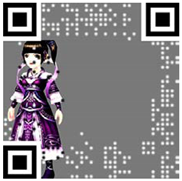 |  |  |
| Images | Average Error Bytes | Error-Correction Rate (Average Error Bytes/Total Length of Code Words) |
|---|---|---|
| Human image data set (400) | 2.2 | 1.6% |
| Scene image data set (400) | 4.1 | 3.1% |
| Cartoon image data set (400) | 1.4 | 1.0% |
| Average | 2.6 | 1.9% |
| Images | Huang et al. [11] | Cox et al. [21] | [26] | Ours |
|---|---|---|---|---|
| Image 1 | 63.20 | 147.32 | 67.45 | 36.76 |
| Image 2 | 64.55 | 171.32 | 67.26 | 25.34 |
| Image 3 | 61.19 | 127.94 | 77.80 | 43.28 |
| Image 4 | 62.85 | 177.80 | 68.91 | 21.36 |
| Image 5 | 62.78 | 214.12 | 73.09 | 24.23 |
| Image 6 | 63.63 | 203.54 | 63.64 | 35.45 |
| Image 7 | 70.89 | 160.99 | 65.48 | 40.31 |
| Average | 64.16 | 171.85 | 69.09 | 32.39 |
| Input Images | Results | Input Images | Results |
|---|---|---|---|
 |  |  |  |
 | 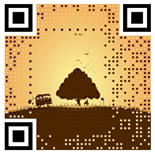 |  |  |
 |  |  |  |
 |  |  |  |
| Mobile Phone | APP | Decoding Rates of 100 Images |
|---|---|---|
| HUAWEI Honor 7 | Wo Cha Cha | 98% |
| 96% | ||
| QRcode Scanner | 100% | |
| MI 5 | Wo Cha Cha | 98% |
| 97% | ||
| QRcode Scanner | 99% | |
| iPhone 6 | Wo Cha Cha | 100% |
| 99% | ||
| QRcode Scanner | 100% | |
| i-nigma | 100% |
© 2018 by the authors. Licensee MDPI, Basel, Switzerland. This article is an open access article distributed under the terms and conditions of the Creative Commons Attribution (CC BY) license (http://creativecommons.org/licenses/by/4.0/).
Share and Cite
Lu, J.; Cheng, W.; Zhang, S.; Li, L.; Yang, Z.; Chang, C.-C. A Novel Aesthetic QR Code Algorithm Based on Hybrid Basis Vector Matrices. Symmetry 2018, 10, 543. https://doi.org/10.3390/sym10110543
Lu J, Cheng W, Zhang S, Li L, Yang Z, Chang C-C. A Novel Aesthetic QR Code Algorithm Based on Hybrid Basis Vector Matrices. Symmetry. 2018; 10(11):543. https://doi.org/10.3390/sym10110543
Chicago/Turabian StyleLu, Jianfeng, Weiling Cheng, Shanqing Zhang, Li Li, Zaorang Yang, and Chin-Chen Chang. 2018. "A Novel Aesthetic QR Code Algorithm Based on Hybrid Basis Vector Matrices" Symmetry 10, no. 11: 543. https://doi.org/10.3390/sym10110543
APA StyleLu, J., Cheng, W., Zhang, S., Li, L., Yang, Z., & Chang, C.-C. (2018). A Novel Aesthetic QR Code Algorithm Based on Hybrid Basis Vector Matrices. Symmetry, 10(11), 543. https://doi.org/10.3390/sym10110543






